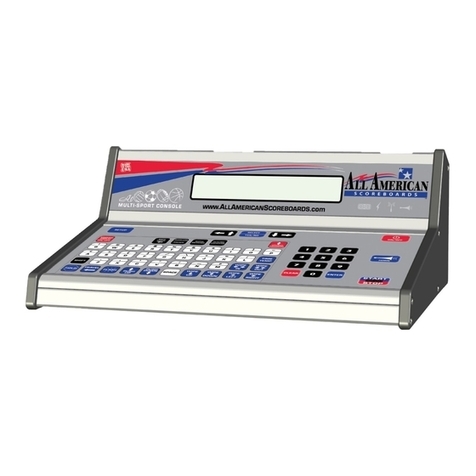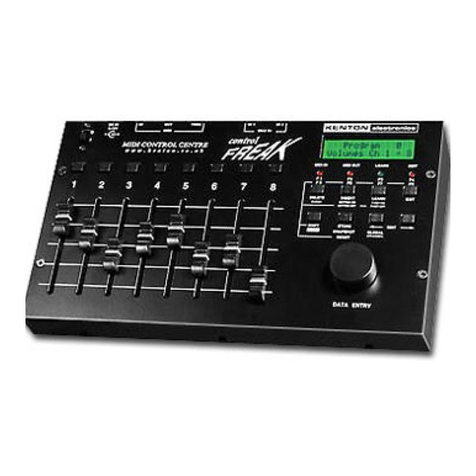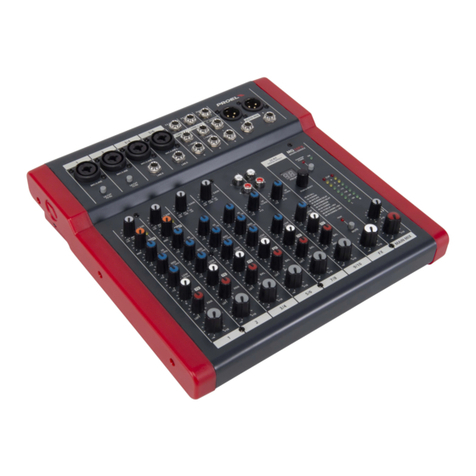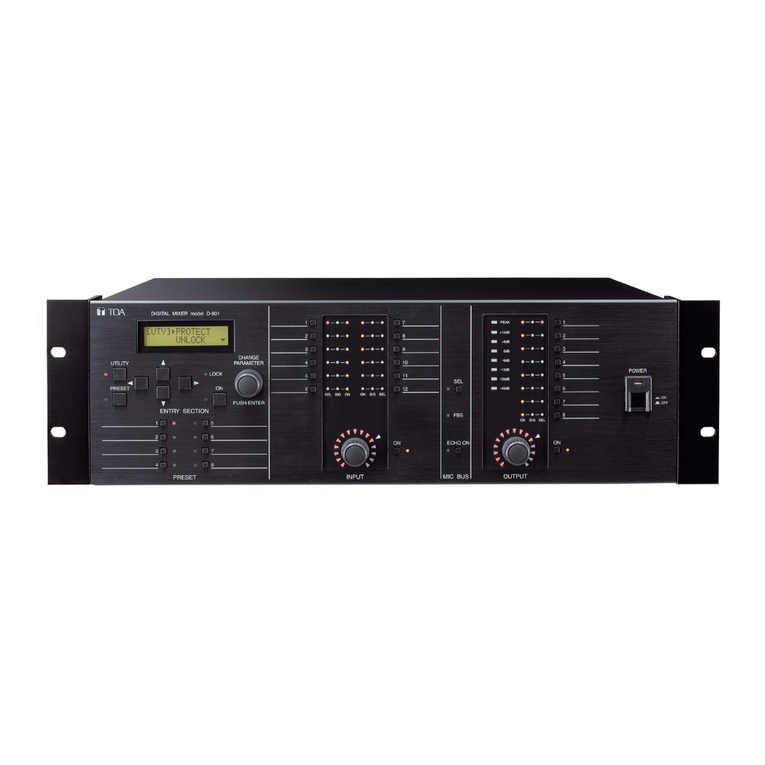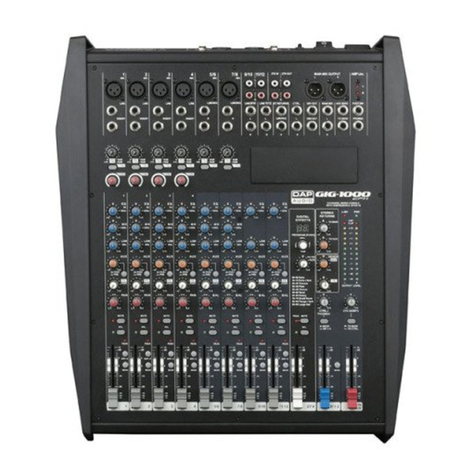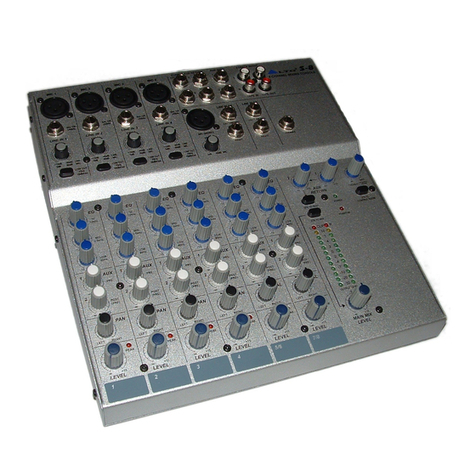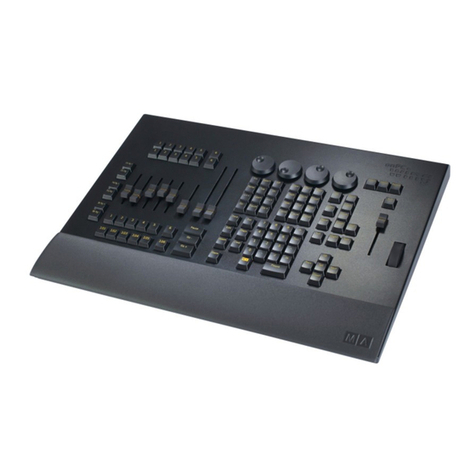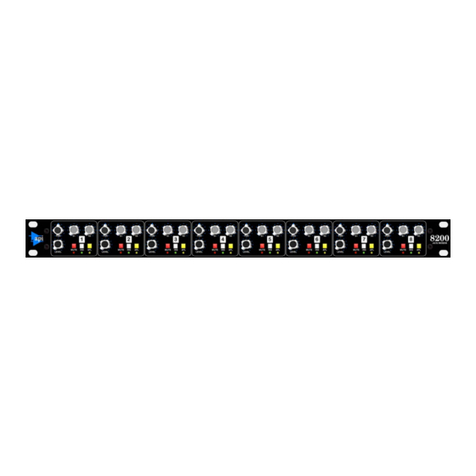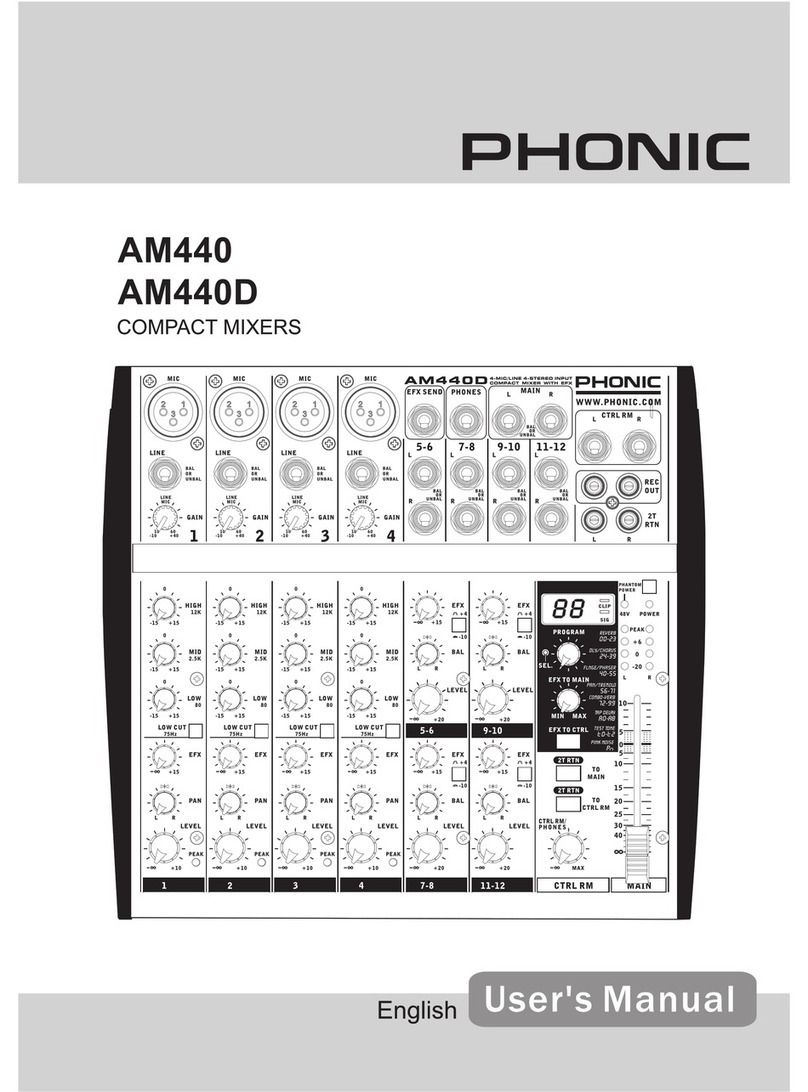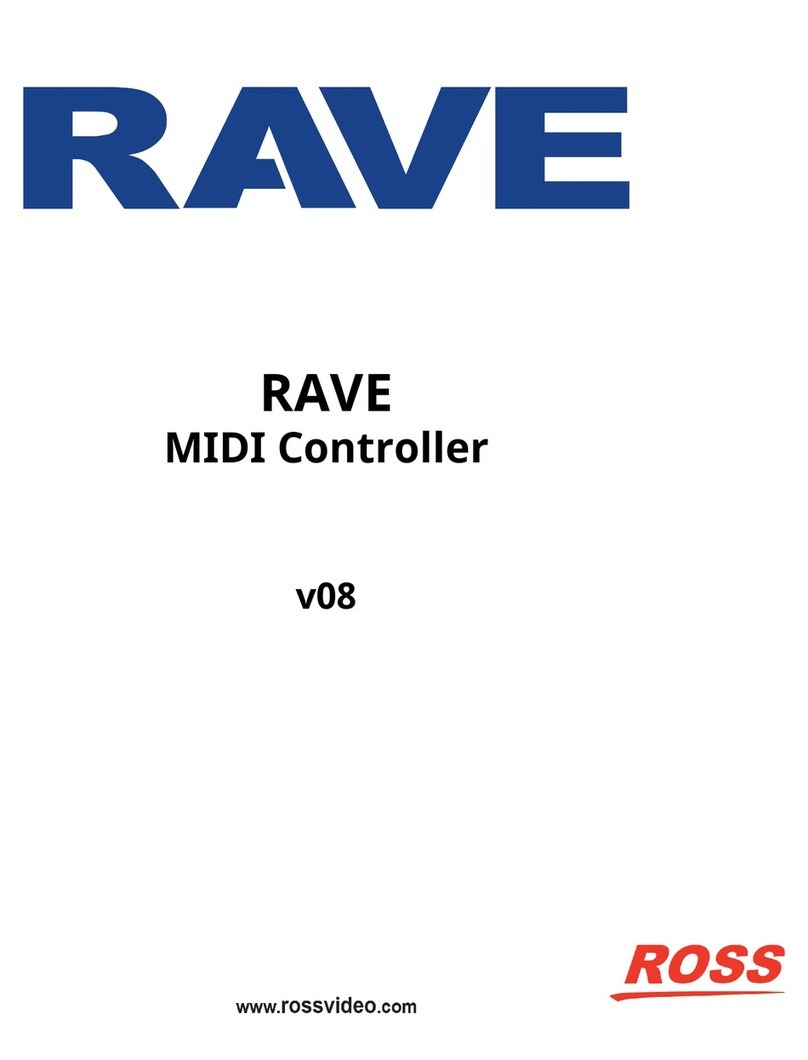EMI TG 12345 Mk.II User manual

HANDBOOK OF THE
EMI AUDIO MIXER
TG 12345 Mk.II
RESEARCH LABORATORIES OF ELECTRIC & MUSICAL INDUSTRIES LTD.
HAYES MIDDLESEX ENGLAND

LIST OF CONTENTS
1. INTRODUCTION
2. GENERAL
2.1 Terminology
2.1.1 Drawing Numbers
2.1.2 Signal Levels
2.2 General Drawings
2.3 Mechanical Components
2.4 Electrical Components and features
2.4.1 Active units
2.4.2 Mixing
2.4.3 Power Supply
2.4.4 R.F. Rejection and Earthing
2.4.5 Metering
2.4.6 Switching
2.4.7 Frequency Response
2.4.8 Gain
2.4.9 Echo Circuits
2.4.10 Cue Circuits
3. MICROPHONE CASSETTE
3.1 Channels
3.2 Input Socket
3.3 Condensor Microphone Powering
3.4 Input Circuits
3.4.1 Coarse Input Level Control
3.4.2 Input Amplifier and Fine Gain Control
3.4.3 Range of Input Levels
3.4.4 Re-Record Inputs
3.4.5 Test Input
3.5 Signal Path
3.5.1 Band Pass Filter
3.5.2 Compressor/Limiter
3.5.3 Inject
3.5.4 Presence Control
3.5.5 Bass Control
3.5.6 Fader
3.5.7 Pan Pot
3.5.8 Output Circuits
3.6 Solo Facilities
3.7 Cue Channels
3.7.1 Cue Level Control
3.7.2 Cue Line Selector
3.7.3 Cue Bus Lines
3.8 Echo Circuits

3.8.1 Echo Level control
3.8.2 Echo Selector
3.8.3 Echo Bus Lines
3.9 Power Supply
4. GROUP CASSETTE
4.1 Contents
4.2 Group Channel
4.2.1 Input Gain Control
4.2.2 Limiter/Compressor
4.2.3 Inject
4.2.4 Fader
4.2.5 Poling
4.2.6 Presence Control
4.2.7 Band Pass Filter
4.2.8 Output
4.3 Echo Output Circuit
4.3.1 Main Level Control
4.3.2 Output Amplifier
4.4 Metering
4.5 Power Supply
5. MAIN CASSETTE
5.1 Contents
5.2 Main Channel
5.2.1 Input Gain Control
5.2.2 Inject
5.2.3 Fader
5.2.4 Poling
5.2.5 Presence Control
5.2.6 Band Pass Filter
5.2.7 Track Announce – Individual
5.2.8 Track Announce – Multi
5.2.9 Output Amplifier
5.3 Cue Circuits
5.4 Auxiliary Stereo
5.4.1 Auxiliary Stereo Channel
5.4.2 Auxiliary Stereo Bus Lines
5.5 Metering
5.5.1 Meter Connections
5.5.2 Meter Amplifier
5.5.3 Meter Selector
5.6 Power Supply
6. TRACK MONITOR CASSETTE
6.1 Function

6.2 Inputs
6.3 Re-Record
6.4 Monitor Channels
6.4.1 Tape Machine Selection
6.5 Echo Channels
6.5.1 Echo Send
6.5.2 Echo Return
6.6 Power Supply
7. CONTROL ROOM MONITOR CASSETTE
7.1 Function
7.2 Loudspeaker Channel
7.2.1 Input Key
7.2.2 Input Amplifiers
7.2.3 Monitor Selectors
7.2.4 Level Control
7.2.5 Pole
7.2.6 Solo
7.2.7 Control Room Loudspeaker Switch
7.2.8 Loudspeaker Circuit – Remote Operation
7.2.9 Loudspeaker Circuit – Direct
7.2.10 Loudspeaker Line Output
7.3 Record/Replay Switches
7.3.1 Tape Replay Selection
7.3.2 Record/Replay
7.4 Correlator
7.4.1 Correlator Switch
7.4.2 Correlator
7.4.3 Low Level Meters
7.4.4 Meter Connection
7.5 Synchronous Replay
7.5.1 Input
7.5.2 Synchronous Replay to Cue
7.6 Cue Output
7.7 Cue to Loudspeaker
7.8 Metering
7.9 Signalling
7.10 Power Supply

8. STUDIO PLAYBACK CASSETTE
8.1 Function
8.1.1 Synchronous Playback
8.2 Loudspeaker Channels
8.2.1 Input Selectors
8.2.2 Level Controls
8.2.3 Pole
8.2.4 Loudspeaker Switch
8.2.5 Studio Talkback
8.2.6 Output
8.3 Talkback
8.3.1 Operator’s Microphone
8.3.2 Gain
8.3.3 Studio Talkback – Normal
8.3.4 Studio Talkback – Loud
8.3.5 Artist Manager’s Microphone
8.3.6 A.M. Gain
8.3.7 A.M. Mixing
8.3.8 R.F. Suppression
8.4 Alternative Talkback
8.5 Intercom
8.6 Cueing
8.6.1 Operator to Cue
8.6.2 Artist Manager to Cue
8.7 Track Announce
8.7.1 Signal
8.7.2 Switching – Separate Tracks
8.7.3 Switching – Multi-track
8.8 Oscillator
8.8.1 Frequencies
8.8.2 Level
8.8.3 Distortion
8.8.4 Tape Machine Test
8.9 Metering
8.10 Power Supply
9. FRAME
9.1 Capacity
9.2 Cassette Requirements
9.3 Construction
9.4 Cableform
9.4.1 Main Cableform
9.4.2 Power Cableform

10. MAIN POWER UNIT
10.1 Function
10.2 A.C. Constant Voltage Transformer
10.3 Step Down Transformer
10.4 Relay Power Supply
10.5 Buzzer Operation
10.6 Red Light Operation
10.7 Microphone Powering
10.8 Metering
11. CIRCUIT DESIGN – GENERAL PRINCIPLES
12. CIRCUIT DESCRIPTION – INDIVIDUAL BOARDS
12.1 Presence
12.2 Bass
12.3 Amplifier Type A
12.4 Amplifier Type B + B
12.5 Amplifier Type C
12.6 Amplifier Type E
12.7 Band Pass Filter F
12.8 Amplifier Type G
12.9 Amplifier Type G + B
12.10 Amplifier Type H
12.11 Amplifier Type J
12.12 Amplifier Type K
12.13 Amplifier Type M
12.14 Amplifier Type N
12.15 Q Power Unit
12.16 Amplifier Type Q
12.17 Amplifier Type R
12.18 Correlator
12.19 Amplifier Type U
12.20 Oscillator
12.21 Cassette Power Unit
12.22 Limiter
12.23 Active Relays
12.24 Solo Relay
12.25 Re-Record Attenuator
12.26 Track Announce Relay
12.27 Amplifier Type D
12.28 Amplifier Type P
12.29 Microphone Power Unit
12.30 Injection Unit (Specification)

1 Introduction.
The mixer has been designed to meet the following requirements:
1.1 To be suitable for fixed or mobile use.
1.2 To be light, easily dismantled and transported.
1.3 To comprise cassettes, which can be assembled in different
combinations, to form mixers with up to 24 inputs for up to 8-track
recording.
1.4 When a multi-track recording is being made, to provide for
simultaneously feeding a 2-track stereo tape machine.
1.5 To be complete with all foreseeable facilities required for both
classical and pop recording.
1.6 To have a very high degree of reliability.
1.7 Any faults which may occur to be easily located.
1.8 Spare cassettes to be easily inserted to remove faults.
2. General
2.1 Terminology
2.1.1 Drawing numbers
Throughout this handbook when a reference is made to a Drawing Number, it
assumed to be preceded by TG12345 unless otherwise stated.
2.1.2 Signal levels
Signal voltage levels are expressed in dBv, this being the voltage level in
decibels with respect to 0.447v (this being the r.m.s. voltage across a 200Ωresistor
when dissipating one milliwatt). The figures quoted are not all strictly accurate as
they do not, in general, take into account the loading effect of a high impedance
load across a 200Ωor lower impedance source.
In the manufacturing test specifications which require more precision,
sending levels are expressed in dBi, this being the indicated sending level of a
200ΩGain Set. At an indicated level setting of 0dBi, the gain set would deliver a
zero level signal, 0dBm, i.e. 1 milliwatt, into a 200Ωload. Thus at the output of the
Gain Set when loaded with 200Ω, dBm, dBv and dBi are numerically equal. If the
output is completely unloaded then dBV=dBi + 6.02
2.2 General Drawings
The general scheme of the Mixer is shown on the block schematic, Drawing
number DE1.
The top panel layout of each of the six types of cassette is shown on Drawing
number D143.

The Drawing numbers of the block schematics of the six types of cassette are:
Microphone Cassette DE2
Group Cassette DE3
Main Cassette DE4
Track Monitor Cassette DE5
Control Room Monitor Cassette DE6
Studio Playback Cassette DE7
Main Power supply unit CE8
2.3 Mechanical Components
2.3.1 Cassettes
There are six types of cassettes, which are of uniform size.
These are as follows:
Microphone Cassette described in section 3.
Group Cassette described in section 4.
Main Cassette described in section 5.
Track Monitor Cassette described in section 6
Control Room Monitor Cassette described in section 7.
Studio Playback Cassette described in section 8.
2.3.2 Frame
Two sizes of frame are available and are described in section 9.
The larger frame holds up to 24 cassettes and the smaller frame holds up to 12
cassettes. Blank panels may be fitted if cassettes do not occupy all the channels
available. Blank cassettes are available having plugs to accommodate the unused
sockets on the cableform.
2.3.3 Main Power Unit
This is entirely separate from the frame and is preferably located some
distance therefrom. If the tape machines are in a separate machine room, the Main
Power unit could be in the same room.
The Main Power Unit is described in section 10.
2.4 Electrical Components and Features
2.4.1 Active Units
Each cassette contains a multiplicity of active units, each of which is
designed to perform a specific function. This enables the internal signal level in the
Mixer to be kept substantially constant, thereby making possible an extremely good
signal to noise ratio and very low power consumption. Many of the active units are
used in more than one type of cassette thereby simplifying manufacture and the
maintenance of a stock of spare components.
These active units are described in Section 12.

2.4.2 Mixing
Although a mixer has to perform many functions other than that of mixing,
nevertheless, this function is of predominant importance on account of the
multiplicity of input and output channels which may be involved.
In the present Mixer facilities are provided for mixing the signals from
microphone channels and applying them to group channels, for mixing signals from
microphone and/or group channels, for mixing signals from main channels and
applying them to the inputs of auxiliary stereo main channels and for mixing
auxiliary signals from various channels to send to echo or cue circuits.
In order to provide for this, each output which may require to be mixed with
signal from another channel is provided with an amplifier B which operates as a
voltage to current converter and each input into which signals are to be mixed is
provided with an amplifier C which has a virtual earth input. The circuit values are
chosen so that when an amplifier C2 follows an amplifier B, the overall gain is unity.
The output impedance of the voltage to current converter is of the order of 20kΩ
and the virtual earth input impedance is of the order of 20Ω. Thus each extra
channel which is connected to the mixing point only changes the impedance at that
point by 0.1% and therefore changes the gain of existing channels by about 0.01dB.
Thus, the connection of 20 extra channels changes the gain by 0.2dB, which is
negligible.
2.4.3 Power Supply
Since a mixer for recording purposes will always be used with one or more
mains powered tape machines, there is no need to provide for battery operation of
the mixer. It is therefore designed to operate from 200/250V, 50 to 60Hz mains. If it
were essential to be able to operate from a battery or other d.c. supply, a d.c. to a.c
converter could be used.
Each cassette has a Power Unit attached to its underside, which provides
positive and negative 20V supplies from series stabilisers. The low output
impedance and the very low ripple level enable supply decoupling circuits to be cut
to a minimum. Most of the amplifiers have no decoupling.
It is advantageous for equipment to work over a considerable range of mains
voltages without any tap changing or other adjustment being necessary. If the series
stabilisers had been designed to cope with this, there would have been greater heat
dissipation in the series transistors. Although most components will operate
satisfactorily over a considerable range of temperatures, it is in general
advantageous to keep temperature rise to a minimum. A d.c. stabiliser, which gives
an output of 240V ±1% for a range of input voltage from 204 to 252, is therefore
included in the Main Power Unit. This is followed by a step-down transformer, which
gives an output at 50V with a centre tap, which is earthed. This balanced 50V
supply is fed to the power transformers of all the cassette power units through a
screened twisted pair cable. The cassette power transformer only has to handle
about 5 watts and is therefore quite small. It is enclosed in a magnetic screening
can to minimise the risk of mains hum injection into the audio channels of the mixer.

With this method of supply, the Mixer desk is classed as an “extra low
voltage” piece of equipment and it is therefore not legally necessary to bond its
metalwork to the mains earth, but this is normally done.
2.4.4 RF Rejection and Earthing
Any long lead connected to the mixer is liable to act as an aerial and feed RF
into the mixer where, if the level is sufficiently high, it may be rectified and result in
audible interference on the programme material.
This is counteracted by providing every input and output with a screened
transformer. These are placed as close as possible to the respective input and
output sockets and screened leads are used to connect the sockets to the
transformers.
The inter-winding screen of each transformer is connected to the chassis of
the cassette. The chassis of a cassette may become electrically connected to the
mixer frame by the fixing screws, but as the top panel of the cassette is painted, and
the fixing screws chrome plated, this cannot be relied upon. Interconnection of the
chassis is effected through a lead in the main cableform and four ways of each of
the multi-way plugs and sockets used for signal interconnections. As an added
precaution each cassette is provided with a screw terminal and a heavy gauge lead
with spade terminals, provides a very low resistance linkage.
Since all signal interconnections between cassettes are unbalanced, it is
most important that the common earthy return line should be of low resistance or
cross talk may be introduced.
The common signal point in each cassette, which is also the common point
of the positive and negative 20V lines, is insulated from the chassis, thereby
facilitating the tracing of earth faults in components or wiring. This is also connected
to the corresponding point of each of the other cassettes through four ways in
parallel of the multi-way plug and the main cableform. These interconnecting leads
in the main cableform, and the spade terminal interconnecting lead, each have a
spur near the centre provided with a spade tag. These are connected together and
to the main frame of the mixer at a terminal on the frame, at which point the whole
system may be connected to any suitable earth. In some circumstances it may be
impossible to obtain an earth, but even under these conditions the system gives
satisfactory results.
2.4.5 Metering
A VU meter is provided for each Main Cassette output, these being the
outputs which feed signal to the tape machines. The meters are mounted in a meter
box, which is part of the mixer frame. Since each Main Cassette contains two main
channels, two meters per cassette are required and these are mounted one above
the other, the upper meter being connected to the left channel and the lower being
connected to the right channel. The frame has a flying lead terminating in a 7-pin
plug for each pair of meters. Each main cassette has a corresponding 7-pin socket
carrying the VU meter signals. Since the mixer operating level is lower than normal
VU meter level, the meters are fed through amplifiers. These derive their input
signals prior to the output amplifiers and under normal conditions they give an
indication of 0VU when the open circuit output voltage is 0.447V rms. Under these
conditions the input voltage to the meter amplifier is 10dB less than this.

Since a VU meter is a linear and not a logarithmic meter, the scale becomes
very cramped at the lower end of the scale. The range of indication is extended by
providing each Main Cassette with two locking push buttons. One of these
increases the gain of both VU meter amplifiers by 10dB, and the other increases the
gain by 20dB.
The inputs of the VU meter amplifiers are connected to a selector switch
whereby they may be connected to the follow/replay key for measuring record and
replay levels, to the inputs to the particular Main Cassette, to the selector switches
in the Group, Control Room Monitor or Studio Playback Cassettes for measurement
of levels in these cassettes, to an external socket for measurement of levels in other
equipment, or to the –10dBV oscillator line. If a mixer has more than one Main
Cassette, the cableform is wired so that only the first Main Cassette (i.e. Tracks 1 &
2) can be used for measurements in the Control Room Monitor and Studio Playback
cassettes and this Main Cassette is also connected for measurements in the left
hand Group Cassette. The second Main Cassette is used for measurements in the
second Group Cassette. All VU meters can be switched simultaneously if desired, to
the test oscillator so that their sensitivities and frequency response may be checked.
There are also meters associated with the Compressor/Limiters and the
correlator, the indications of which will be dealt with later.
2.4.6 Switching
Stud or keyswitches are used for signal switching where these can be used
without excessive complication of the switch or wiring.
Where multiple and/or remote switching is required, it is then effected by
using transistors as switches. In this way the use of electro-mechanical relays,
which tend to be large, heavy and power consuming, has been avoided in the signal
circuits.
Transistor switching is used in the following circuits:
The solo facility described in 3.6, whereby the signal in any one microphone
channel may be heard on the left hand control room monitor loudspeaker, the right
hand speaker being simultaneously muted, without interfering with the recording.
The track announce circuitry described in 5.2.7 and 5.2.8, which provides a
separate button for each track and a further button for announcements on all tracks
simultaneously.
The operator and artist manager talkback circuitry described in 8.3.
2.4.7 Frequency response
In previous generations of mixers, each channel has included several
transformers which have provided appreciable attenuation at frequencies above and
below the audio band. This is advantageous since it is undesirable that unwanted
frequencies should be indicated on the programme meters, or recorded on the
master tape. As the present mixer only has two transformers per channel and as
these have wide pass bands, particularly in the bass, each channel in each cassette
is provided with a Band Pass Filter, which is described in 12.7.

Since each channel contains several separate active units, d.c. blocking
capacitors are required at the interconnections. Many of these feed into resistive
potentiometer controls, the impedance of which has been limited to a maximum of
about 6kΩin order to avoid excessive impedance at the slider. In order to avoid
clicks when the control is operated, it is necessary to use capacitors with very low
leakage currents. Hence, polyester and polycarbonate types have been selected.
Very large and bulky components would be required if the total bass loss of a
cassette were to be kept less than 0.1dB at 30Hz. Smaller capacitors are therefore
used and an adjust on test (AOT) resistor in the Band Pass Filter on each channel is
selected on test so that the bass rise of the filter before it begins to attenuate, just
balances the attenuation of the couplings.
In this way the response is kept substantially flat down to 30Hz. Below this
the Band Pass Filter cuts at 12 dB per octave and the coupling capacitors increase
this rate. The Band Pass Filter has a further A.O.T. resistor for trimming the overall
high frequency (20kHz) gain of each channel of each cassette.
2.4.8 Gain
In general, the gain of an active unit is determined by the ratio of two
feedback resistors, the forward gain being so high that it has a negligible effect. The
resistors employed are of the high stability type and their values are specified to
±1%. The errors in the overall gain due to deviation of resistor values can be
cumulative and the unbalance of a pair of channels could be considerable of errors
were of opposite sign. This is overcome without the use of very close tolerance
resistors by providing one active unit in each channel of each cassette with an
A.O.T. resistor for setting the gain of that channel to the nominal value. This also
covers variations in the ratios of transformers, which are also specified to ±1%.
The amplifiers in which the gain is trimmed are Amplifiers E, G and K. Some
channels have two separate amplifiers B. As it would not be economical to adjust
the gain of these, the gain determining resistors of these are specified to ±0.5% to
ensure a balance of gain within 0.1dB between the channels.
When measuring gain of mixer channels, all inputs should be fed from a
200Ωsource. All outputs have an impedance of about 200Ωand are designed to
feed a load of 2kΩor greater. Thus a gain set with a 200Ωsending unit and a
bridging receive unit is required. For fault finding or for checking purposes it may be
necessary to measure the gain of an individual cassette. A cassette output, which
feeds a bus line, is intended to work into an amplifier C, which has a virtual earth
input. A test rig intended for this measurement is therefore provided with an
amplifier C3, which is similar to an amplifier C2, but with a feedback resistor with a
closer tolerance.
For testing a cassette having an Amplifier C at its input, a resistor of
6k8 ±0.5% is used to build out the Gain Set sending impedance to provide a current
source.

2.4.9 Echo Circuits
Each microphone channel has an echo send level control and a switch
whereby a signal, which is tapped off after the fader, can be routed to any of four
echo lines.
Solely for convenience, and not because there is any association, the echo
output circuits are located in the Group Cassettes, two output circuits being included
in each Group Cassette. Thus if three or four echo output circuits are required, the
mixer must have two Group Cassettes. Switching is provided whereby the echo
output level may be observed on the VU meters.
A normal microphone channel is used for each echo return and the signal,
suitably controlled, can be fed to any track or pair of tracks. If it is required to record
without echo but to listen with echo on the monitor speakers, signal from the
channels in the Track Monitor Cassette can be fed to the echo bus lines and the
output of any microphone channel used as an echo return can be switched so that it
is injected into the required channel. A total of eight inject lines is available. If the
mixer provides for eight track recording plus auxiliary stereo, six of the inject lines
connect to the monitor channels associated with the first six of the eight tracks, and
the remaining two, Nos. 4A and 4B connect to the auxiliary stereo monitor channels
5A and 5B.
2.4.10 Cue Circuits
Two cue circuits are provided. Signal from any microphone channel is tapped
off prior to the fader and fed through a level control to a switch whereby it can be fed
to either of the two cue bus lines, or both of them simultaneously without introducing
cross talk. Signal from each main channel circuit can also be fed to either or both of
the cue bus lines, in this case separate level controls being provided.
Main cue level controls and line output amplifiers are provided in the Control
Room Monitor Cassette, switching being provided whereby the output level may be
observed on the VU meters. This cassette also contains level controls whereby two
synchronous replay signals, designated left and right, which are routed through the
Studio Playback Cassette, can be fed to the cue circuits, left to cue 1 and right to
cue 2. The synchronous replay signals and the cue bus signals are available on the
input selector switches of the Control Room Monitor and Studio Playback Cassette
so that any of these signals can be fed to the control room or studio loudspeakers.
The zero level cue signals from the Control Room Monitor Cassette are fed
to small power amplifiers located in the main power unit. These will provide a very
loud signal for up to six pairs of 50Ωheadphones in parallel or will operate a small
8Ωloudspeaker. A selector switch and two level controls are provided to enable the
Artist Manager to communicate through the cue circuits. The Operator has a key
switch, which connects the output from his microphone through separate pre-set
level controls to both cue circuits.

3. MICROPHONE CASSETTE
3.1 Channels
Each Microphone Cassette contains two identical channels, which can be
used either for two mono microphones or for a stereo pair.
3.2 Input Socket
A 5-pin Tuchel socket is used for the two inputs. Each input is provided with a
screened input transformer having a step-up ratio of 1: 3.16 the primary winding of
which is intended to operate from a 200Ωsource.
3.3 Condenser Microphone Powering
Provision is made for 50V phantom powering of condenser microphones. A
pair of 6.8 kΩresistors the values of which are balanced to within 0.5% is
connected in series across each input circuit. The common points of these two
pairs are connected to the sliders of a 2-pole 4-way switch whereby neither, either
or both can be connected to the positive side of a 50V D.C. supply. The unit
providing this supply is located in the main power unit. Its output is brought in a pair,
with the 50V a.c. supply to the Control Room Monitor Cassette. It is then distributed
to the Microphone Cassettes through the main cableform. The negative side of this
supply is connected to the 0 V line in the Control Room Monitor Cassette.
3.4 Input Circuit
3.4.1 Coarse Input Level Control
The Coarse input level control provides 12 steps of attenuation of 5dB each.
In order to maintain a high input impedance, and to ensure that the noise of the
channel is less at all intermediate settings of the input level control than at the zero
loss setting, the first three 5dB steps are obtained from tappings on the input
transformer secondary winding. The remaining steps are obtained by means of a
resistive potentiometer of 8.33kΩtotal resistance.
3.4.2 Input amplifier and Fine Gain Control
This is an Amplifier D described in 12.27. Its nominal voltage gain is 25dB.
Used as it is in conjunction with the fine input gain control, which has a range of
±5dB in 0.5dB steps, an effective voltage gain from 20 to 30dB can be obtained.
The fine gain control operates in the feedback circuit of the Amplifier D.
3.4.3 Range of Input Levels
For the standard level of –10dBV at the output of the Amplifier D, the level at
the input of the Amplifier D can be between –30 and –40dBV. The level at the
secondary of the transformer can therefore be between +30 and –40dBV so that the
corresponding range of input voltage is from +20 to –50dBV.

3.4.4 Re-Record Inputs
Each coarse input level control has a further five positions in which it can
select signals for re-recording via the microphone input bus lines. There are ten of
these lines numbered 1A to 5A and 1B to 5B. The A series being available on the
left hand channel of each Microphone Cassette and the B series being available on
the right hand channel of each Microphone Cassette. These bus lines are fed at a
level of –10dBV from the outputs of Amplifiers A1 in the Track Monitor Cassettes,
line 1A, 1B, 2A and 2B coming from the extreme left Track Monitor Cassette, lines
3A, 3B, 4A and 4B coming from the next cassette and lines 5A and 5B coming from
the extreme right hand Track Monitor Cassette this being the one for use with the
Auxiliary Stereo tape machines.
Between each bus line and the corresponding stud on the input selector
control a 25dB loss resistive pad is inserted to reduce the level from –10 to –35dBV.
The fine gain control is available to give ±5dB of fine adjustment of the level.
3.4.5 Test Input
The extreme anticlockwise position of each coarse input level control makes
connection with an oscillator bus line. The Oscillator is located in the Studio
Playback Cassette and, when the Oscillator level control is at 0, the level on this bus
line is –35dBV, this being the standard level at the point of injection.
3.5 Signal Path
3.5.1 Band Pass Filter
The output of each Amplifier D is connected to the input of a Band Pass
Filter, the circuit of which is described in 12.7. These contain adjust on test (AOT)
resistors whereby the overall frequency response of the channel is trimmed.
The output of the Band Pass Filter is at about –6V and is directly connected
to the input of the Compressor/Limiter. In order not to apply this potential to the
inject socket an a.c. coupling consisting of a 6.8µF capacitor and 33kΩresistor is
inserted.
3.5.2 Compressor/Limiter
This is described in 12.22. A 3-position locking key is provided in each
channel, the positions being marked “Out”, “Compress” and “Limit”. In the Out
position, the Compressor/Limiter is removed from the forward path but its input is
left connected so that its meter indicates the signal level.
A Third locking key is provided which is marked Gang. When this is set to
the forward position the two compressor/limiters are controlled by which ever of the
two control voltages is instantaneously the greater. When this is used the two other
keys should both be set to Compress or Limit. The hold and recovery controls are
coaxial. The recovery control is the lower of the two and is a stud switch with six
positions numbered 1 to 6. The recovery times corresponding to these positions are
approximately 0.1, 0.25, 0.5, 1, 2 and 5 seconds respectively. An approximate
calibration of the hold control which is a logarithmic 10kΩcarbon potentiometer is
marked on the panel. Normally the hold control will be adjusted prior to a take and

the setting is then most easily made by observing the relevant limiter meter and
setting the hold control so that the meter reads the desired number of decibels of
compression or limiting. If it is found necessary to alter the hold control during a
take, the calibration on the panel will be found useful but it is not as precise as the
meter reading. When the compressor/limiters are ganged only the left hand hold
control functions.
Connection is made to both the meters through a 7-way chassis mounting
socket on the rear of the cassette and a mating plug on a flying lead from the meter
box of the console. The socket also has the +20V, 0V and –20 V lines connected to
socket pins 3, 4 and 5 respectively for test purposes.
3.5.3 Inject
Although the mixer is intended to be completely self-contained with all normal
facilities, occasions may arise when, to produce some unusual effect, it is necessary
to introduce some other device. For this purpose an inject socket for each channel
is provided on the underside of the chassis. For normal operation this must be
provided with a plug with pins 1 and 2 shorted together. The external device must
be connected through an injection unit, which complies with the specification given
in 12.30. This requires the provision of input and output transformers to maintain r.f.
rejection and to remove the possibility of earth loops.
3.5.4 Presence Controls
The circuit of these is described in 12.1. Each channel has two controls.
One of these is marked dB Presence and provides 0, 2, 4, 6, 8 or 10dB boost or cut
at the frequency selected by the other, which is marked kHz Presence. The
frequencies available are 0.5, 0.8, 1.2, 1.8, 2.8, 4.2, 6.5 and 10kHz. The curves
obtained in the ±10dB conditions are shown on Drawing No. 376.
3.5.5 Bass Control
This provides a flat position and five 2dB steps of lift or cut. Although it is
called a bass control, the frequency of half lift or cut is actually 500Hz. The
frequency response obtained at the various settings is shown in Drawing No. 375.
The circuit is described in 12.2. Since the circuit has no output capacitor, a 6.8µF
capacitor is provided externally with 150kΩto the 0 V line to prevent a large plop
when the fader is inserted.
3.5.6 Fader
This follows the bass control and is a quadrant type instrument, in which the
control enters through a bearing near the bottom, thereby minimising the entry of
dust. It has two chains of resistors connected in parallel. The sliders are staggered
half a stud and the resistors are such that the instrument provides 30 steps of 0.5dB
followed by a graded law of 26 steps to –64dB and Off. The input resistance is
3.19kΩand, when fed from a low impedance, it gives its indicated voltage loss into
50kΩ. Since the fader is designed to feed a 50kΩload, a buffer amplifier is
necessary between it and the following pan pot and echo level controls in parallel.

Since the setting of the fader for standard level through the channel is at 5dB
loss, it is desirable that this amplifier should have 5dB of voltage gain. The Amplifier
E serves this purpose. Its input impedance is 50kΩand its output is designed to
feed a pan pot and echo level control in parallel. Its circuit is described in 12.6
3.5.7 Pan-pot
This consists of two reverse connected potentiometers each having a total
resistance of 11kΩwith the inputs in parallel. If the outputs from the sliders are fed
to a stereo channel, the control may be used to pan the signal full left, full right or to
any of 19 intermediate positions. The extreme positions provide the means of
switching the signal to either of two output channels that are not a stereo pair.
3.5.8 Output Circuits
Each pan-pot slider is connected to the input of an Amplifier B which acts as
a voltage to current converter. This amplifier is described in 12.4.
The outputs of the two Amplifiers B in one channel are connected to the
sliders of the output selector, a 2-pole, 11-way stud switch. The extreme
anticlockwise position is “off”. For a current source, the normal connection for “off”
is a short circuit. If however this stud were connected to the 0V line, since the
switch is of the shorting type, the transition from the first to second stud would put a
short circuit on the input of the amplifier connected to the second stud. As this is a
virtual earth input amplifier, it generates a click under these conditions. This is
avoided by using a 3.3kΩresistor on the first stud and this provides a reasonably
low load for the Amplifier B in the off position.
The remaining ten positions of the channel selectors are connected to bus
lines. In each case the channel to which signal is fed when the pan pot is in its
anticlockwise position is connected to an A bus line and the other channel
(clockwise pan pot) to a B bus line. The A and B bus lines feed to the left and right
channels of the subsequent cassette. Provision is made for two Group Cassettes
(G1A, G1B, G2A and G2B), for four Main Cassettes (Main 1A, 1B to 4A, 4B) and for
eight channels (Monitor 1A to 4B) to Track Monitor Cassettes. If a mixer has less
than the maximum numbers of Group, Main and Track Monitor cassettes, some of
these bus lines will not be used.
The purpose of the monitor bus lines is to allow a recording to be made
without added echo but to be able to listen to it on the monitor speakers with added
echo. In this case, the cassette selector of the microphone channel used for echo
return is switched to the desired monitor channel where it is added to the direct
signal. (See 6.5.2)
Although with 8-track and simultaneous auxiliary stereo working there are 10
monitor channels in use, it is thought that the 8 monitor inject channels provided are
quite adequate. In this set up lines 1A, 1B, 2A and 2B, are routed to the extreme
left hand Track Monitor Cassette, lines 3A and 3B to the upper channels of the
second Track Monitor Cassette and lines 4A and 4B to the upper channels of the
Track Monitor Cassette at the right hand end of the Mixer, this being the one used
for the auxiliary stereo channels.

3.6 Solo Facility
3.6.1
This facility allows signal from any microphone channel to be fed to the left-
hand monitor loudspeaker in the control room without interfering in any way with any
recording which is in progress, the right hand loudspeaker being simultaneously
muted.
3.6.2
To allow the signal or noise on a channel to be heard when the fader is
closed, the tapping is taken from the input to the fader, and, in order to provide
isolation, is fed to the input of an Amplifier G. This amplifier, which is described in
12.8, has a voltage gain of unity and a low output impedance.
3.6.3
Each channel is provided with a push button located near the upper end of
the fader. Operation of this button connects the output of the Amplifier G through a
16kΩresistor to the solo bus line and also operates the solo active relay in the
Control Room Monitor Cassette. This relay removes existing signals from the
loudspeakers and feeds signal from the bus line to the left-hand speaker.
3.7 Cue Channels
3.7.1 Cue Level Control
In order that a signal from a channel may be available for cueing purposes
when the fader is closed, the cue tapping must be taken from the input side of the
fader. This is the same point as is used for the solo facility so the output of the
Amplifier G is also fed to the cue level control, a logarithmic 5kΩcarbon
potentiometer.
3.7.2 Cue Line Selector
The slider of the cue level control potentiometer is connected to the cue
channel selector whereby the inputs of two Amplifiers B may neither, either or both
be connected thereto. In positions where an amplifier input is not connected to the
signal line, it is connected to the 0V line.
3.7.3 Cue Bus Lines
The outputs of the two Amplifiers B in each microphone channel are
connected to the Cue 1 and Cue 2 bus lines which are connected to the Cue Line
Output circuits in the Control Room Monitor Cassette.
3.8 Echo Circuits
3.8.1 Echo Level Control
The Echo Level Control is connected in parallel with the pan-pot. It is a
miniature stud switch potentiometer of about 6.8kΩtotal resistance. It provides 20
steps of 2dB of attenuation and an “off” position. This control is used in several
places in the Mixer and is referred to as the general-purpose attenuator. In this

particular case it is scaled from –40dB in the penultimate anticlockwise position to
0dB in the fully clockwise position.
3.8.2 Echo Selector
The output of the level control is fed to an Amplifier B and thence to the echo
selector whereby it may be connected to any of four echo bus lines. There is also
an “off” position in which the amplifier output is connected to the 0V line through a
3.3kΩresistor for the reason described in 3.5.8. The Amplifier B shares a board
with the Amplifier G in the cue circuit.
3.8.3 Echo Bus Lines
Echo bus lines Nos. 1 and 2 connect to echo line output circuits in the left
hand Group Cassette and lines Nos. 3 and 4 connect to similar circuits in the right
hand Group Cassette. (See 2.4.9) If there is only one Group Cassette then only
Nos. 1 and 2 echo send circuits are available.
3.9 Power Supply
A cassette power unit, the circuit of which is described in 12.21 is mounted
on the underside of the cassette. It receives its input at 50V with an earthed centre
tap, 50 or 60Hz on a 6-pin plug. This is of the same type as the 7-pin plug used
elsewhere but pin 2 is removed and socket 2 is plugged so that they are not
interchangeable. Soldered connections are made between the +20, 0 and –20V
outputs of the power unit and the corresponding rails of the cassette. The +20, 0
and –20V outputs also appear on pins 3, 4 and 5 respectively of the input plug for
test purposes.
The maximum rating of the power supply unit is 75mA at +20V and 120mA at –20V.
The microphone cassette actually consumes 58mA at +20V and 82mA at –20V.
4. GROUP CASSETTE
4.1 Contents
Each Group Cassette contains two identical and independent group channels
and two identical and independent Echo Line Output circuits.
4.2 Group Channel
4.2.1 Input Gain Control
The input to each group channel is a group bus line and therefore requires to
feed into an Amplifier C the circuit of which is described in 12.5. At this point, it is
desirable to have some degree of gain control. Firstly, the level at the input will
increase with increasing number of input channels. Doubling the number of
channels will result in a 3dB increase if the signals are not related or a 6dB increase
of the signals are identical. Secondly, if the signal has been limited in the

Microphone Cassette and if the fader is set to 0, the output of the Microphone
Cassette will be a standard level signal as measured by the limiter meter which is a
peak reading meter. Depending on the signal waveform this may be substantially
less than a standard level signal as measured on a V.U. meter where it will be fed to
the tape machine. In the first case, it is desirable to have less gain available and in
the second case more gain is required. The standard Amplifier C2 has a feedback
resistor of such value that an Amplifier B plus an Amplifier C2 has unity overall gain.
In this case an Amplifier C1 is employed. This has a feedback resistor of greater
value than the C2 and this, when shunted by the input gain control provides a range
of ±10dB in 2dB steps.
4.2.2 Compressor/Limiter
This is identical in every respect with that in the Microphone Cassette (see
section 3.5.2). The controls and meters are identical and are similarly positioned.
The a.c. coupling, consisting of 6.8µF and 33kΩbetween the C1 Amplifier output
and the Out-Compress-Limit key, would at first sight appear to be superfluous since
the Amplifier C1, itself has an output coupling capacitor. The Compressor/Limiter
introduces a small amount of bass loss when feeding into the fader. This bass loss
is counteracted by trimming the band pass filter. The a.c. coupling introduces a
bass loss equal to that of the compressor limiter and maintains a similar frequency
characteristic whether or not the Compressor/Limiter is in circuit.
4.2.3 Inject
This is identical with the facility provided in the microphone channels (see
3.5.3).
4.2.4 Fader
The fader used is electrically identical with that in the microphone channels.
In this case, the left-hand fader is provided with an optional mechanical ganging
device. If the two faders are set to the same reading and the projection on the right
hand side of the left-hand control knob is pressed home, the two faders can be
operated as a ganged pair. The two controls can easily be separated by lifting the
ganging member.
4.2.5 Poling
As some channels may be routed directly from Microphone to Main
Cassettes and other channels may be routed through a Group Cassette, it is
essential that a Group Cassette should not introduce a reversal of polarity. As the
circuit of this cassette is one side earthy throughout, each channel must contain an
even number of active elements, which produce a reversal of polarity. The Amplifier
C, Amplifier B and Band Pass Filter all reverse so it is necessary to add a fourth.
Therefore, instead of using an Amplifier E to counteract the 5dB loss of the fader at
its normal operating point as in a microphone channel, an Amplifier K, which gives a
phase reversal, is used for this purpose. The circuit of the Amplifier K is described
in 12.12.
Table of contents
